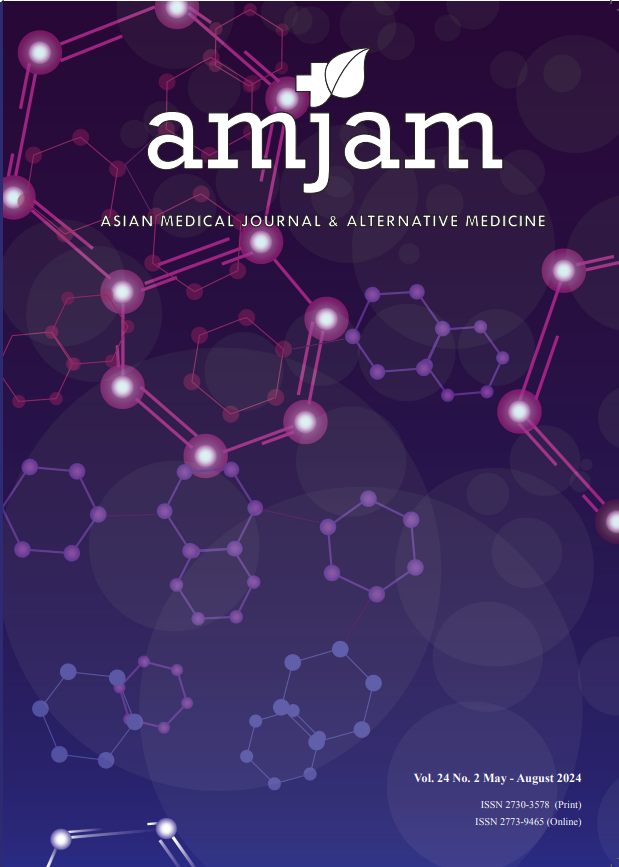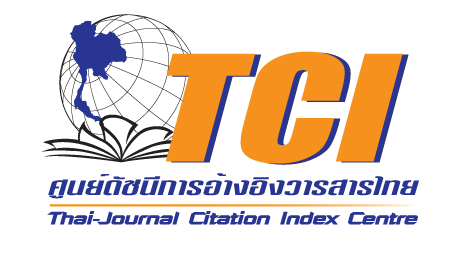Unveiling the Botanical Riches: Enhancing Quality Control and Stability Assessment of Sa-Tri-Lhung-Klod Remedy Extract Through HPLC Profiling and Anti-inflammatory Potency Evaluation
Keywords:
Sa-Tri-Lhung-Klod remedy, Quality control, Stability testing, HPLC, Anti-inflammatory activityAbstract
Introduction: Sa-Tri-Lhung-Klod (ST) remedy is a Thai traditional medicine preparation, used for post-partum care including excreting amniotic fluid, reducing inflammation, and improving blood circulation. The standard quality values and the stability of ST have not been reported. Quality control and stability testing are necessary to determine and insure the standard quality of ST remedy.
Objectives: To evaluate the quality control of herbal components according to Thai Herbal Pharmacopoeia (THP). The stability of ST extracts was examined using high performance liquid chromatography (HPLC) and anti-inflammatory activity was measured.
Methods: The quality assessment of the ST and plant components was performed by moisture content, total ash, acid-insoluble ash, extractive value, and tannin content, following the THP method. The stability testing of ST extracts stored under accelerated conditions for six months was performed, and the percentage of the remaining compounds were evaluated using HPLC and tested for anti-inflammatory activity on nitric oxide (NO) inhibitory assay in RAW264.7 cells.
Results: Quality control of ST and plant components met THP requirements, and the tannin content of ST increased upon extraction. ST ethanolic extract (STE) and the remaining compounds exhibited stability after 6 months and anti-inflammatory activity on nitric oxide inhibition assay was retained from day 0 to day 180. However, ST aqueous extract (STW) was unstable from day 30.
Conclusions: The first report of quality control and stability testing of ST is outlined. ST and plant components comply with THP standard requirements. STE can be stored at room temperature for up to two years, whereas STW requires refrigeration in order to extend its shelf life.
Downloads
References
Meepradit K. Effect of postpartum herbal of Kab-Choeng hospital, Surin province. [MSc Thesis]. Bangkok: Silpakorn University; 2011.
Mokmued K, Ruangnoo S, Itharat A. Anti-inflammatory of the ethanolic extract of Thai traditional post-partum remedy (Sa-Tri-Lhang-Klod) and plant ingredients. Thammasat Medical Journal. 2017; 17(4): 557-564.
Inprasit J, Ruangnoo S, Itharat A. In vitro cytotoxic activity of Sa-Tri-Lhung-Klod remedy and its herbal ingredients on ovarian and cervical carcinoma cell lines. J Med Assoc Thai. 2014;97 (Suppl 8):S149-S155.
Zahiruddin S, Parveen A, Khan W, et al. Quality Control and Stability Testing of Arq Formulations of Unani Pharmacopeia of India Using HPTLC and GC-MS. J AOAC Int. 2020;103(3):699-704.
WHO Regional Committee for the Eastern Mediterranean. Draft Regional guideline for the WHO eastern mediteranean region: Stability testing of active substance and pharmaceutical products. Jeddah: WHO Regional Office for the East Mediterranean; 2006.
Department of Thai Traditional and Alternative Medicine. Thai Herbal Preparation Pharmacopoeia. Nonthaburi: Ministry of Public Health; 2022.
Department of Medical Sciences. Thai Herbal Preparation Pharmacopoeia 2021. Nonthaburi: Ministry of Public Health; 2021.
European Medicine Agency. ICH topic Q1A (R2) stability testing of new drug substances and products, Note for guidance on stability testing: stability testing of new drug substances and products (CPMP/ICH/2736/99). London, England: EMEA;2006.
Inprasit J, Itharat A, Ruangnoo S, et al. Ethnopharmacological analysis based on Thai traditional medicine theory and anti-inflammatory activity of Sa-Tri-Lhung-Klod remedy as a post-partum anti-inflammatory drug. J Ethnopharmacol. 2024;319(Pt 2):117207.
Makchuchit S, Rattarom R, Itharat A. The anti-allergic and anti-inflammatory effects of Benjakul extract (a Thai traditional medicine), its constituent plants and its some pure constituents using in vitro experiments. Biomed Pharmacother. 2017;89:1018-1026.
Chokevivat V. Quality of crude drug. J. Thai Trad Alt. Med. 2004;2:84-91.
Liu K. New and improved methods for measuring acid insoluble ash. Anim Feed Sci Technol. 2022;288:115282.
Ambreen M, Mirza SA. Evaluation of anti-inflammatory and wound healing potential of tannins isolated from leaf callus cultures of Achyranthes aspera and Ocimum basilicum. Pak J Pharm Sci. 2020;33(Suppl 8):361-369.
Mota ML, Thomas G, Barbosa Filho JM. Anti-inflammatory actions of tannins isolated from the bark of Anacardium occidentale L. J Ethnopharmacol. 1985;13(3):289-300.
Soares S, Brandão E, Guerreiro C, Soares S, Mateus N, de Freitas V. Tannins in Food: Insights into the Molecular Perception of Astringency and Bitter Taste. Molecules. 2020;25(11):2590.
Tewtrakul S, Tungcharoen P, Sudsai T, Karalai C, Ponglimanont C, Yodsaoue O. Antiinflammatory and Wound Healing Effects of Caesalpinia sappan L. Phytother Res. 2015;29(6):850-856.
Ying X, Yu K, Chen X, et al. Piperine inhibits LPS induced expression of inflammatory mediators in RAW 264.7 cells. Cell Immunol. 2013;285(1-2):49-54.
Sornkaewa N, Lin Y, Wang F, et al. Diarylheptanoids of Curcuma comosa with inhibitory effects on nitric oxide production in macrophage RAW 264.7 cells. Nat Prod Commun. 2015;10(1):89-93.
Downloads
Published
How to Cite
Issue
Section
License
Copyright (c) 2024 Asian Medical Journal and Alternative Medicine

This work is licensed under a Creative Commons Attribution-NonCommercial-NoDerivatives 4.0 International License.



